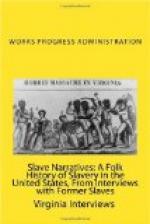“About the only game I can remember playing as a child was a doll game. The Crawford children would use me for the doll, and then when my turn came to play mamma and claim one of them for my doll, Miss Fanny or Miss Sue would appear and then I would have to be a doll for them. I didn’t mind, for I dearly loved them all.
“Now about Raw Head and Bloody Bones; I am going to tell you, Miss, my Marster’s people were cultured and refined, and they wouldn’t allow such things told to their own children or to their slaves’ children. They didn’t want anything said or done to frighten any little children, and if a nurse or anyone else was caught doing such a thing, that person was punished for it. With the heritage of training like that I could hardly be expected to believe in such things.
“Marse John was grand to sick slaves. He always sent for Dr. Moore, who would make his examination and write out his prescription. When he left his parting word was usually ’Give him a sound thrashing and he will get better.’ Of course he didn’t mean that; it was his little joke. Dr. Holt, Dr. Crawford Long, and Dr. Jones Long were sometimes called in for consultation on particularly serious cases. We didn’t like Dr. Moore and usually begged for one of the other doctors. I don’t think my white folks used teas made of herbs, leaves or roots; they may have, but I don’t remember it. However, I do know that we wore little sacks of asafetida around our necks to keep off diseases, and the white folks wore it too.
“On the day we learned of the surrender, the Negroes rallied around the liberty flag pole that they set up near where the city hall is now. All day long they cut up and there was a song they sung that day that went something like this:
’We rally around the flag pole of
liberty,
The Union forever, Hurrah!
Boys Hurrah!’
“Next morning when the Negroes got up the white folks had cut that pole down. We were mortally afraid of the Yankees when they appeared here a short time after the surrender. We were afraid of the Ku Klux Klan riders too. The Negroes did act so bad; there were lots of killings going on for a long time after the war was supposed to be over.
“Mother was glad and sorry too that she was free. Marse John had been so good to all his slaves that none of them really wanted to leave him. We stayed on a while, then mother left and rented a room. She worked hard and bought a house as soon as she could; others did the same. There were very few slaves that had any money at all to begin on.
“Immediately following the surrender northern people opened Knox Institute. One of my teachers was Miss Dora Brooks, a white woman from the North. The principal was a white man, he was Mr. Sortur. After I graduated from Knox Institute, I went to the Atlanta University four years, then came back to Athens and taught school here forty years. I taught whatever grade they assigned me to each year, never any certain grade from year to year. First and last, I’ve taught from first grade through high school. I would be teaching now if it were not for my bad health. I receive a teacher’s pension, but have never applied for an old age pension.




